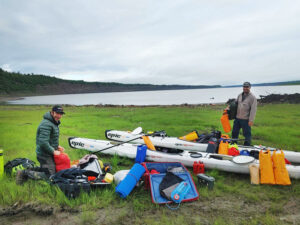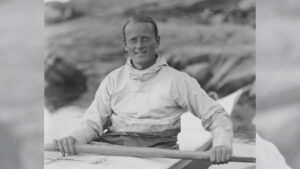Today, four Canadian kayakers completed an 800km, 27-day paddle from arctic Quebec down to Nain, the northernmost town on the Labrador coast.
From the time J.F. Marleau, Justine Curgenven, Frank Wolf, and Larry Chomyn left Kangiqsualujjuaq until the tired group pulled into Nain this morning, they could not expect to meet anyone. No villages lie along the way, just arctic wilderness and one of the highest density of polar bears in the world.
Three of the team were qualified kayak guides. The fourth, Frank Wolf, does frequent paddle sport adventures.

The route. Map: Tongait Expedition
High tides, few landing spots
The beginning of the journey took them through six-meter tides and broad tidal flats. McLelan Strait, a narrow channel between Ungava Bay on the west coast and the Labrador Sea on the east, features swift currents that change direction every few hours. However, this early in the season, they had to wrestle their kayaks over sea ice that had not yet cleared out.
Once on the Atlantic side, they entered Torngat Mountains National Park, a rarely visited wilderness. The northern tip has many protective islands and ample beaches, but the 130km between Seven Islands Bay and Saglek Bay featured few islands, long days and unbroken stretches of cliffs with few places to land, even in good weather.
Still, for experienced kayakers, the main difficulty is the many polar bears that prowl the beaches. On Instagram, Larry Chomyn reported “lots of bears, caribou, seals, a few whales, and one walrus.”
Historic background
The last party to kayak that entire route from northern Quebec through McLelan Strait and down the coast of Labrador to Nain was British kayak builder Nigel Foster and his partner Kristin Nelson in 2004. Jill Fredston and her husband Doug kayaked the entire Labrador coast twice during two separate summers; it featured as a chapter in her excellent book, Rowing to Latitude.
In 2006, my wife Alexandra and I kayaked 500km from eastern McLelan Strait along the length of the Torngats. It was the first “tourist” visit to the new national park. During one period of six days, we had to deal with 11 polar bears from 20 meters away and less.
A few wilderness canoeists likewise did that coastal route in the 1980s and early 1990s. However, none have attempted it since the polar bear population exploded in the 1990s — the result, some biologists suggest, of the earlier moratorium on harp seal hunting. Since then, harp seals have flourished off the north coast of Labrador.






